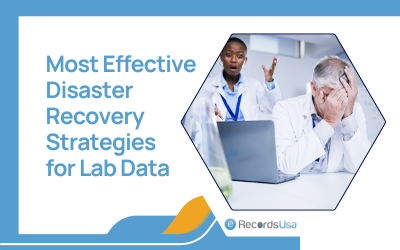
What Are the Most Effective Disaster Recovery Strategies for Lab Data?
What would happen if your handwritten lab notebooks were lost in a fire, flood, or accidental mishap?
For many research labs, years of critical data — experiment records, methodology notes, sample tracking, and observations — are still captured in physical lab notebooks. While they hold immense intellectual value, they remain vulnerable to disasters, degradation, or human error, with no reliable backup. In a worst-case scenario, the permanent loss of such documentation could set back years of research, compromise reproducibility, or even violate compliance protocols.
Disaster recovery strategies for lab data must begin with securing your most irreplaceable records — and that starts by digitizing handwritten lab notebooks into high-quality, searchable, and preservable formats. By converting analog data into accessible digital formats, labs can ensure better data continuity, improved access control, and long-term protection against physical data loss.
This article explores the key strategies for building a disaster recovery plan centered around data digitization and retention. It includes how services like eRecordsUSA help labs protect valuable intellectual property by providing secure, high-resolution scanning and digital archiving solutions tailored specifically for scientific and research environments.
Why Lab Data Requires Specialized Disaster Recovery Strategies?
Lab data isn’t just information — it’s the backbone of discovery, intellectual property, regulatory accountability, and scientific credibility. But many labs still rely on handwritten notebooks, paper-based protocols, and physical documentation that are fragile, irreplaceable, and often siloed.
Unlike typical digital files, physical lab records are prone to degradation, accidental damage, environmental exposure, and organizational loss. More importantly, they often hold the only copy of original experiments, calibration notes, and observations that are required for audits or reproducibility.
A single event — such as a fire, flood, chemical spill, or even simple misplacement — can result in irreversible data loss.
Here’s what makes lab data uniquely vulnerable:
- Volume & Complexity – Labs generate large volumes of data — from experimental notes to sample identifiers — often distributed across binders, boxes, and handwritten pages with no centralized repository.
- Compliance Sensitivity – Regulatory frameworks like Good Laboratory Practices (GLP) and GxP require that original data, including lab notebooks, be retained, legible, and accessible for audits. Loss or degradation of these records can lead to non-compliance or data integrity issues.
- Reproducibility Requirements – Scientific validation relies heavily on the ability to reproduce experimental results. If original handwritten documentation is lost or illegible, the scientific value of the data is compromised.
- No Built-in Redundancy – Unlike digital systems with automatic backups, physical records have no recovery mechanism unless they’ve been professionally scanned and digitally archived.
This is why disaster recovery strategies for lab data must begin with a data digitization plan — one that converts vulnerable analog records into secure digital formats. With services like eRecordsUSA, labs can professionally scan handwritten notebooks into indexed, searchable, and compliance-friendly digital archives, ensuring long-term preservation and protection against physical loss.
Key Components of a Lab Disaster Recovery Plan
Once the risks to handwritten lab data are understood, the next step is building a disaster recovery plan (DRP) specifically tailored for physical-to-digital data workflows. A well-crafted DRP ensures that vital research documentation is digitized and protected, accessible, and recoverable in the event of disruption.
Below are the essential components that make a disaster recovery plan effective for lab environments still reliant on handwritten records:
1. Data Identification & Prioritization
Begin by identifying which lab notebooks and physical records are mission-critical, compliance-sensitive, or irreplaceable. Prioritize scanning based on:
- Experimental value
- Regulatory relevance
- Frequency of use
Pro Tip: eRecordsUSA helps labs audit and organize large volumes of historical notebooks before digitization.
2. High-Resolution Digitization & Indexing
Once prioritized, the records must be professionally scanned using high-resolution imaging, ensuring:
- Legibility under magnification
- Support for faded ink, smudges, or damaged pages
- Inclusion of metadata for searchability (e.g., researcher name, date, project)
- Use of a specialized book scanner that performs non-destructive scanning, ensuring books are returned in the same condition they were received
Pro Tip: eRecordsUSA uses advanced imaging technology designed specifically for biotech lab notebook preservation, enabling accurate research data scanning without risking any physical damage.
3. Secure Digital Archiving
Digital files should be stored in redundant, secure repositories with role-based access and encryption where possible.
4. Retention & Retrieval Policies
A disaster recovery plan should define:
- How long digitized records are retained?
- How and who can retrieve them?
- How file integrity is monitored over time?
This ensures data governance and supports audit readiness.
5. Testing and Validation
At regular intervals, labs should simulate retrieval or file recovery scenarios. Test:
- Whether digitized records are intact
- Whether files are retrievable by intended users
- Whether SOPs for data access are up to date
By incorporating these core components into your disaster recovery planning, you create a foundation of data resilience — where scientific records are preserved and protected even if the originals are lost. This approach safeguards research and positions your lab to meet evolving compliance and reproducibility standards.
Compliance-Driven Planning – Meeting Regulatory Expectations
In research and scientific labs, disaster recovery isn’t just about safeguarding data — it’s also about maintaining compliance with regulatory and quality standards that require accurate, secure, and accessible documentation.
For labs that still rely on handwritten notebooks, physical damage or data loss could mean more than lost research — it could mean regulatory violations, audit failures, or legal liability.
Why Regulatory Compliance Depends on Proper Recordkeeping?
Regulatory frameworks require that lab documentation be:
- Accurate and complete
- Legible and durable over time
- Protected against unauthorized changes or damage
- Accessible during audits or inspections
If a notebook is lost, water-damaged, faded, or misfiled — and there’s no digital backup — the lab could face:
- Loss of data integrity
- Inability to reproduce experiments
- Compliance breaches
Key Standards That Emphasize Data Preservation
| Standard or Framework | 🔍 Relevance to Lab Notebooks |
|---|---|
| GLP (Good Laboratory Practice) | Requires proper storage and handling of original research records |
| GMP / GxP | Emphasizes traceability, legibility, and documentation integrity |
| HIPAA (for clinical research) | Requires secure and accessible records for any health-related data |
| ISO 9001 / ISO 13485 | Requires control over quality documents and long-term access |
How Digitization Supports Regulatory Expectations?
By converting handwritten lab notebooks into high-quality digital formats, labs can:
- Ensure permanent legibility, even if originals degrade
- Enabling quick retrieval of records during audits or inspections
- Protect against physical loss due to fire, flooding, or human error
Through secure scanning services, eRecordsUSA helps labs create searchable, organized, and audit-ready digital archives of their physical notebooks — preserving compliance-critical records without requiring full digital lab management systems.
Moreover, eRecordsUSA emphasizes non-destructive scanning techniques using specialized book scanners, ensuring compliance standards are met while books are returned in the same condition as received.
We ensure that books integrity is maintained, and not destroyed in the digitization process. In the eyes of regulators, if it’s not retrievable, it doesn’t exist. A disaster recovery plan that includes professional digitization ensures that your records remain verifiable, accessible, and inspection-ready, no matter what threats your physical documents may face.
Real-World Example: When Records Are Gone, They’re Gone
Real-world events have highlighted the irreversible risks of not digitizing important records. In 2014, the Boles Fire in Weed, California, destroyed the Holy Family Catholic Church, resulting in the complete loss of its sacramental registers — documentation that held decades of irreplaceable information.
This incident is a sobering reminder: whether in religious institutions or scientific laboratories, physical-only records remain vulnerable to disaster. Digitization is the only way to preserve their integrity and ensure recoverability.
Check out the complete information about this incident here:
Disaster Recovery Methods – Why Digitization Comes First?
When it comes to protecting lab data, especially from handwritten notebooks, digitization is the foundation upon which all other disaster recovery strategies are built. Without converting physical records into digital formats, recovery isn’t possible — no matter how advanced the infrastructure.
Below is a breakdown of key recovery concepts and how digitization plays a vital role in each:
| Recovery Method | What It Means | Why Digitization Is Essential | How eRecordsUSA Supports It |
|---|---|---|---|
| Digitization | Scanning handwritten lab notebooks into searchable, high-resolution files | Creates the baseline digital format for any backup, recovery, or archive strategy | Provides secure, high-quality scanning & file output optimized for long-term use |
| Local Storage | Files stored on internal servers, external hard drives, or NAS devices | Only works if data exists digitally; physical notebooks can’t be “backed up” | Digitized files can be easily stored on local lab infrastructure |
| Offsite Storage | Storing data at a secondary physical or cloud-based location | Protects against local disasters (fire, theft, etc.) | Delivers portable digital files that can be uploaded to any secure platform |
| Disaster Recovery Software | Tools that automate file backup, version control, and failover | Can’t include paper documents unless digitized | Digitization enables seamless integration with any DR software |
All recovery methods depend on one thing: the data must already be in a digital format. Without digitization, labs are at risk — no matter how advanced their infrastructure.
Services like eRecordsUSA help research teams secure their most vulnerable records by providing professional digitization — the critical first step in any lab disaster recovery plan.
Lab Data Lifecycle & Retention – Planning for Long-Term Integrity
Digitizing your lab notebooks is just the first step. Once physical records are converted into digital assets, labs must think about how those files will be managed over time — from secure storage to future retrieval and eventual archiving or expiration.
This is where a well-defined lab data lifecycle and retention policy come in — ensuring your digitized records remain accessible, compliant, and protected for the long haul.
What Is the Lab Data Lifecycle?
The lab data lifecycle refers to the stages your lab records go through, from their creation to their final disposition. In the context of digitized notebooks, this includes:
| Stage | Description |
|---|---|
| Capture | Scanning handwritten notebooks into digital files |
| Classify & Index | Adding metadata: experiment type, project, author, date |
| Store & Protect | Saving files in secure storage locations (on-site or offsite) |
| Access & Retrieve | Controlled access for audits, analysis, or reproducibility |
| Archive or Dispose | Long-term storage or secure deletion after the retention period ends |
Why Retention Policies Matter in Labs?
Many labs operate under compliance mandates that require data to be:
- Retained for specific timeframes (5, 10, or even 25 years)
- Not altered or overwritten
- Available on demand during audits or investigations
Failing to retain research documentation properly can:
- Jeopardize grant funding
- Lead to failed regulatory audits
- Undermine scientific reproducibility
How eRecordsUSA Supports Lifecycle Management?
With eRecordsUSA’s high-quality scanning and indexing, labs can:
- Create searchable digital archives aligned with their retention policy
- Easily sort or filter documents by project, researcher, or date
- Store files in formats compatible with institutional or offsite storage systems
Even though eRecordsUSA doesn’t host data, our digitization service ensures that labs can plug files into any preferred storage solution, setting the stage for consistent long-term management.
Tools & Technologies – How Digitization Enables Resilient Data Management
While many labs today are exploring digital transformation, a large number still rely on handwritten notebooks, physical binders, and paper-based records. For these labs, implementing disaster recovery strategies doesn’t begin with software — it starts with technology that converts physical data into digital assets.
That’s where high-resolution scanning, metadata tagging, and structured archiving become essential tools in the disaster recovery toolbox.
Digitization Tools: Laying the Foundation
Before any backup, archiving, or disaster recovery system can function, the data must exist digitally. Here’s how digitization acts as the enabler:
| Technology | Purpose | Role in Disaster Recovery |
|---|---|---|
| High-Resolution Scanners | Captures handwritten records in exact detail | Ensures legibility and accuracy for long-term use |
| OCR (Optical Character Recognition) | Converts scanned images into searchable text | Enables quick retrieval during audits or reviews |
| Indexing & Metadata Tagging | Categorizes files by project, date, researcher, etc. | Improves organization and traceability of lab records |
| PDF/A & Archival Formats | Ensures long-term compatibility & standardization | Prevents file format obsolescence in future systems |
| Secure Delivery Mechanisms | e.g., encrypted drives or institutional uploads | Maintains data integrity from scan to storage |
Unlike generalized IT systems, scientific documentation has specific requirements: records must be legible, verifiable, organized, and preserved with full context. Tools provided by digitization partners like eRecordsUSA are designed with this in mind — offering:
- True-to-source scans that preserve handwriting, margins, and annotations
- Structured file naming for easy integration into lab record systems
- Searchable file formats that make audits and reference work efficient
Even if your lab plans to store files on local servers, institutional drives, or third-party platforms, the quality of the scanned documents determines their future usability.
Implementation Best Practices and Operational Considerations
Transitioning from handwritten lab notebooks to a secure digital archive requires more than just scanning pages — it requires a structured, thoughtful approach that ensures your records are preserved, accessible, and audit-ready. A strong disaster recovery plan isn’t effective without strategic implementation and ongoing information governance.
Below are best practices labs should follow to maximize the long-term effectiveness of their digitization efforts.
Best Practices for Digitizing and Protecting Lab Records
| Step | Description | Purpose |
|---|---|---|
| 1. Identify and Prioritize Critical Records | Start with notebooks containing experimental data, regulatory documentation, or long-term research | Ensures vital data is digitized first and properly preserved |
| 2. Establish a Metadata and File Indexing System | Tag digital files with project names, dates, researcher IDs, and study types | Improves future access, traceability, and internal organization |
| 3. Define Retention and Archiving Rules | Align document retention periods with regulatory guidelines and institutional policies | Supports compliance, reproducibility, and documentation control |
| 4. Partner with a Qualified Scanning Provider | Choose a service experienced in handling scientific, handwritten materials | Ensures scan fidelity, legibility, and structured file delivery |
| 5. Validate Accessibility and Retrieval Processes | Test how easily users can find and retrieve digitized records when needed | Prepares your lab for audits, inspections, and collaboration needs |
Labs can also benefit from bulk scanning options, where scanning can be done in batches, streamlining large-scale digitization without overwhelming daily operations.
eRecordsUSA supports these best practices by delivering digitized lab notebooks in professionally indexed, high-resolution digital formats.
We also accommodate bulk scanning, allowing scientific institutions to efficiently digitize large volumes of records in one go or in manageable batches. This enables labs to organize, store, and protect their historical records confidently.
Final Checklist and Disaster Recovery Readiness Summary
Implementing an effective disaster recovery strategy for lab data begins with a simple but critical realization: if your records exist only on paper, they are at risk. From environmental threats to compliance obligations, laboratories today need more than just protocols — they need digitally accessible documentation that protects institutional knowledge, satisfies regulators, and supports research reproducibility.
Below is a quick-reference checklist to help your lab assess its current preparedness and identify immediate areas for improvement.
Disaster Recovery Readiness Checklist for Labs
| Checklist Item | Status |
|---|---|
| Have you identified which handwritten notebooks are most critical to research continuity or regulatory compliance? | ☐ Yes ☐ No |
| Are your physical lab records digitized into high-resolution, organized digital files? | ☐ Yes ☐ No |
| Are your digital files indexed with metadata (e.g., researcher, project, date) for easy retrieval? | ☐ Yes ☐ No |
| Do you have a secure storage location for digital versions of lab notebooks (local or offsite)? | ☐ Yes ☐ No |
| Do you have retrieval processes in place in the event of data loss, audit, or disaster? | ☐ Yes ☐ No |
| Are retention policies in place for long-term digital file management based on lab type or compliance needs? | ☐ Yes ☐ No |
Final Thoughts
Disaster recovery is not only about anticipating what can go wrong — it’s about ensuring what matters most is never lost. For labs still relying on paper-based records, digitization is a foundational step toward continuity, compliance, and operational readiness.
Partnering with a trusted provider like eRecordsUSA enables you to:
- Secure your legacy research
- Create organized, compliant digital archives
- Prepare your lab for modern data requirements
Take the first step today by evaluating the state of your lab’s physical records. If you’re ready to convert handwritten lab notebooks into secure, audit-ready digital archives, eRecordsUSA is ready to help you move forward.



